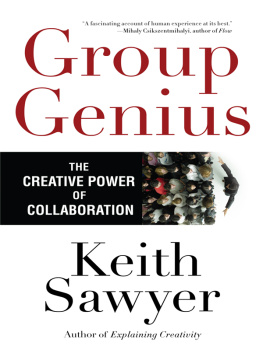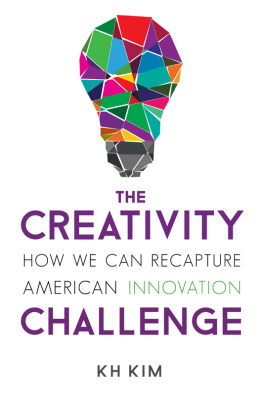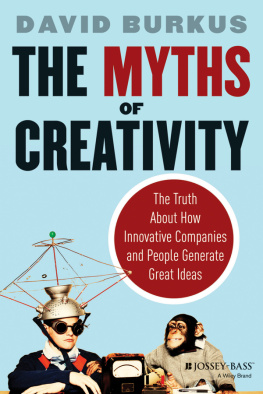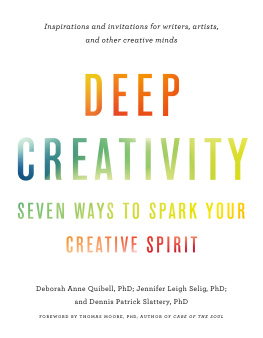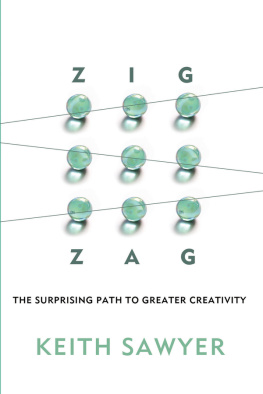
Praise for Group Genius
Keith Sawyer has emerged as the worlds leading scholar on innovative, collaborative creativity. Sawyer is a consummate storyteller and a sure-handed guide to the secrets of success in the ever changing global marketplace. Group Genius is essential reading for anyone who competes in that marketplace.
David Henry Feldman, Professor of Child Development, Tufts University
Group Genius is a lighthouse of a book. It sheds light on knowledge that has always been there but slightly in the dark. The arrival of crowdsourcing is further proof of the extreme validity of Keith Sawyers thesis. Ideas no longer come from some guy in a garage, they come from the meeting of six billion minds.
Alasdhair Macgregor-Hastie, Executive Creative Director at Publicis
So you think that every creative breakthrough is the brainchild of a single lone genius? Think again. Using both scientific research and specific examples, Keith Sawyer makes the strongest possible case for the creativity of collaborative groups.
Dean Keith Simonton, Professor and Vice Chair, Department of Psychology, University of California, Davis
A worthwhile read for anyone who cares about how innovation really works as a functional matter; anyone who runs any kind of an organization; and anyone who ever struggles with trying to do something creative, whether alone or with others.
John Palfrey, Executive Director, Berkman Center for Internet & Society, Harvard Law School
Forget about the myth of the solitary genius: collaborative effort generates ideas and inventions, says this useful, upbeat book... Judiciously wielding exercises and dozens of examples, Sawyer helps the reader understand how people think and function in and out of groups.... this is a solid recipe for unexpected innovation.
Publishers Weekly
An intriguing look at the role of collaboration in creativity and innovation. It will likely challenge your understanding of how innovation happens and how a culture that encourages innovation can be developed within your organization.
Dan Clapper, Asheville (NC) Citizen-Times
Through research with improvisational theater and jazz groups, businesses, and that of social scientists, [Sawyer] shows how successful collaborations have an improvisational nature. He also reveals how the individual mind has an internal collaboration and how insight can be traced to dedication, hard work, and cooperation.
Reference and Research Book News
[Sawyer] affirms that the understanding of creativity as a collaborative process applies not just to prodigies and masterpieces, but also to more ordinary innovation.
Talent Development Resources Blog
I can't stop thinking and talking about Group Genius. It's filled with insightful nuggetsfrom improvisational theater to the advent of Monopoly to Impressionist painting to the invention of the mountain bikeabout teams and the creative process. Whether shedding new light on brainstorming or exploring the subtleties of language, Sawyer made me see creativity in a whole new way.
Ori Brafman, author of The Starfish and the Spider
Group Genius
ALSO BY KEITH SAWYER
Explaining Creativity: The Science of Human Innovation
Group Creativity: Music, Theater, CollaborationCreativity and Development
Improvised Dialogues: Emergence and Creativity in Conversation
Creating Conversations: Improvisation in Everyday DiscourseCreativity in Performance
Group Genius
The Creative Power of Collaboration
KEITH SAWYER
For Barb
Copyright 2007 by R. Keith Sawyer
Hardcover edition first published in 2007 by Basic Books,
A Member of the Perseus Books Group
Paperback edition first published in 2008 by Basic Books
All rights reserved. Printed in the United States of America. No part of this book may be reproduced in any manner whatsoever without written permission except in the case of brief quotations embodied in critical articles and reviews. For information, address Basic Books, 387 Park Avenue South, New York, NY 10016-8810.
Books published by Basic Books are available at special discounts for bulk purchases in the United States by corporations, institutions, and other organizations. For more information, please contact the Special Markets Department at the Perseus Books Group, 2300 Chestnut Street, Suite 200, Philadelphia, PA 19103, or call (800) 255-1514, or e-mail .
Designed by Brent Wilcox
Library of Congress Cataloging-in-Publication Data
Sawyer, R. Keith (Robert Keith)
Group genius : the creative power of collaboration / by Keith Sawyer.
p. cm.
Includes bibliographical references and index.
ISBN-13: 978-0-465-07192-0; ISBN-10: 0-465-07192-9
1. Group problem solving. 2. Creative thinking. I. Title.
HD30.29.S29 2007
658.4'036dc22
2007008007
PB: ISBN: 978-0-465-07193-7
10 9 8 7 6 5 4 3 2 1
INTRODUCTION: BEYOND THE LONE GENIUS
In 2006 CNN asked me to appear on a one-hour special about genius hosted by Sanjay Gupta, MD. The invitation presented a challenge: how to condense into a ten-minute segment my broad expertise and how to choose material that would be especially interesting to viewers. I had ten years of business experience as a management consultant, advising large companies like Citibank and U.S. West on innovation. Id spent fifteen years studying the science of creativity, starting with my PhD in psychology at the University of Chicago. And through it all, Id continued playing jazz piano just as I had back in high school and college.
But it didnt take me long to decide what to present on CNNI took their crew to Chicago to film the onstage collaborations of iO, the influential improvisational theater that launched Mike Myers, Tina Fey, and the late Chris Farley. The reason? Both my research and my real-world experience had led me to the same conclusion: Collaboration is the secret to breakthrough creativity. Id just finished a ten-year study of how Chicago actors improvise dialogue on stage, and Id discovered that group improv was the purest form of collaboration. The rest of the CNN special was about individual geniuswith segments on brain scanning and child prodigiesbut when it came to creativity, the show focused on what I call group genius.
Psychologists are taught to study the individual mindindirectly, through ingenious experiments, or directly, using new technologies to photograph the brain in action. When I began to study creativity, I took the same approach, investigating what happened in the mind when people were being creative. I interviewed jazz musicians, and I developed theories to explain improvisation.
But I quickly became disappointed with this focus on the individual. My years of playing piano in jazz ensembles convinced me that what happened in any one persons mind could never explain what made one nights performance shine and another a dud. At any second during a performance, an almost invisible musical exchange could take the piece in a new direction; later, no one could remember who was responsible for what. In jazz, the group has the ideas, not the individual musicians.
In the business world, Id seen many innovations emerge from a groups genius. In the early 1980s, at my first job after college, I designed video games for Atari. Each game benefited from constant collaboration; I talked to other game designers every day, and we held frequent brainstorming sessions to generate new game ideas. I worked with graphic designers who created the animation sequences that made the characters run, hop, and throw, and musicians who composed those memorable little beeps and boops. And in my next job, while advising Citibank on innovative new technologies, I learned about how John Reed, the CEO, put together a team of key executives to turn the cash machine and the credit card into everyday realities.

